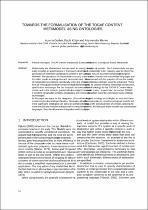JavaScript is disabled for your browser. Some features of this site may not work without it.
- ResearchSpace
- →
- Research Publications/Outputs
- →
- Conference Publications
- →
- View Item
| dc.contributor.author |
Gerber, A

|
|
| dc.contributor.author |
Kotzé, Paula

|
|
| dc.contributor.author |
Van der Merwe, A

|
|
| dc.date.accessioned | 2010-07-14T07:48:29Z | |
| dc.date.available | 2010-07-14T07:48:29Z | |
| dc.date.issued | 2010-06 | |
| dc.identifier.citation | Gerber, A, Kotze, P and Van der Merwe, A. 2010. Towards the formalisation of the TOGAF Content Metamodel using ontologies. 12th International Conference on Enterprise Information Systems (ICEIS), Funchal, Madeira, Portugal, 8-12 June 2010, pp 54-64 | en |
| dc.identifier.uri | http://hdl.handle.net/10204/4075 | |
| dc.description | 12th International Conference on Enterprise Information Systems (ICEIS), Funchal, Madeira, Portugal, 8-12 June 2010 | en |
| dc.description.abstract | Metamodels are abstractions that are used to specify characteristics of models. Such metamodels are generally included in specifications or framework descriptions. A metamodel is for instance used to inform the generation of enterprise architecture content in the Open Group’s TOGAF 9 Content Metamodel description. However, the description of metamodels is usually done in an ad-hoc manner with customised languages and this often results in ambiguities and inconsistencies. The authors are concerned with the question of how the quality of metamodel descriptions, specifically within the enterprise architecture domain, could be enhanced. Therefore we investigated whether formal ontology technologies could be used to enhance metamodel construction, specification and design. For this research, the authors constructed a formal ontology for the TOGAF 9 Content Metamodel, and in the process, gained valuable insight into metamodel quality. In particular, the current TOGAF 9 Content Metamodel contains ambiguities and inconsistencies, which could be eliminated using ontology technologies. In this paper the authors argue for the integration of formal ontologies and ontology technologies as tools into metamodel construction and specification. Ontologies allow for the construction of complex conceptual models, but more significant, ontologies can assist an architect by depicting all the consequences of a model, allowing for more precise and complete artifacts within enterprise architectures, and because these models use standardized languages, they should promote integration and interoperability. | en |
| dc.language.iso | en | en |
| dc.subject | TOGAF content metamodel | en |
| dc.subject | Metamodels | en |
| dc.subject | Enterprise information systems | en |
| dc.subject | Information systems | en |
| dc.subject | Ontologies | en |
| dc.subject | 12th ICEIS 2010 | en |
| dc.title | Towards the formalisation of the TOGAF Content Metamodel using ontologies | en |
| dc.type | Conference Presentation | en |
| dc.identifier.apacitation | Gerber, A., Kotzé, P., & Van der Merwe, A. (2010). Towards the formalisation of the TOGAF Content Metamodel using ontologies. http://hdl.handle.net/10204/4075 | en_ZA |
| dc.identifier.chicagocitation | Gerber, A, Paula Kotzé, and A Van der Merwe. "Towards the formalisation of the TOGAF Content Metamodel using ontologies." (2010): http://hdl.handle.net/10204/4075 | en_ZA |
| dc.identifier.vancouvercitation | Gerber A, Kotzé P, Van der Merwe A, Towards the formalisation of the TOGAF Content Metamodel using ontologies; 2010. http://hdl.handle.net/10204/4075 . | en_ZA |
| dc.identifier.ris | TY - Conference Presentation AU - Gerber, A AU - Kotzé, Paula AU - Van der Merwe, A AB - Metamodels are abstractions that are used to specify characteristics of models. Such metamodels are generally included in specifications or framework descriptions. A metamodel is for instance used to inform the generation of enterprise architecture content in the Open Group’s TOGAF 9 Content Metamodel description. However, the description of metamodels is usually done in an ad-hoc manner with customised languages and this often results in ambiguities and inconsistencies. The authors are concerned with the question of how the quality of metamodel descriptions, specifically within the enterprise architecture domain, could be enhanced. Therefore we investigated whether formal ontology technologies could be used to enhance metamodel construction, specification and design. For this research, the authors constructed a formal ontology for the TOGAF 9 Content Metamodel, and in the process, gained valuable insight into metamodel quality. In particular, the current TOGAF 9 Content Metamodel contains ambiguities and inconsistencies, which could be eliminated using ontology technologies. In this paper the authors argue for the integration of formal ontologies and ontology technologies as tools into metamodel construction and specification. Ontologies allow for the construction of complex conceptual models, but more significant, ontologies can assist an architect by depicting all the consequences of a model, allowing for more precise and complete artifacts within enterprise architectures, and because these models use standardized languages, they should promote integration and interoperability. DA - 2010-06 DB - ResearchSpace DP - CSIR KW - TOGAF content metamodel KW - Metamodels KW - Enterprise information systems KW - Information systems KW - Ontologies KW - 12th ICEIS 2010 LK - https://researchspace.csir.co.za PY - 2010 T1 - Towards the formalisation of the TOGAF Content Metamodel using ontologies TI - Towards the formalisation of the TOGAF Content Metamodel using ontologies UR - http://hdl.handle.net/10204/4075 ER - | en_ZA |






